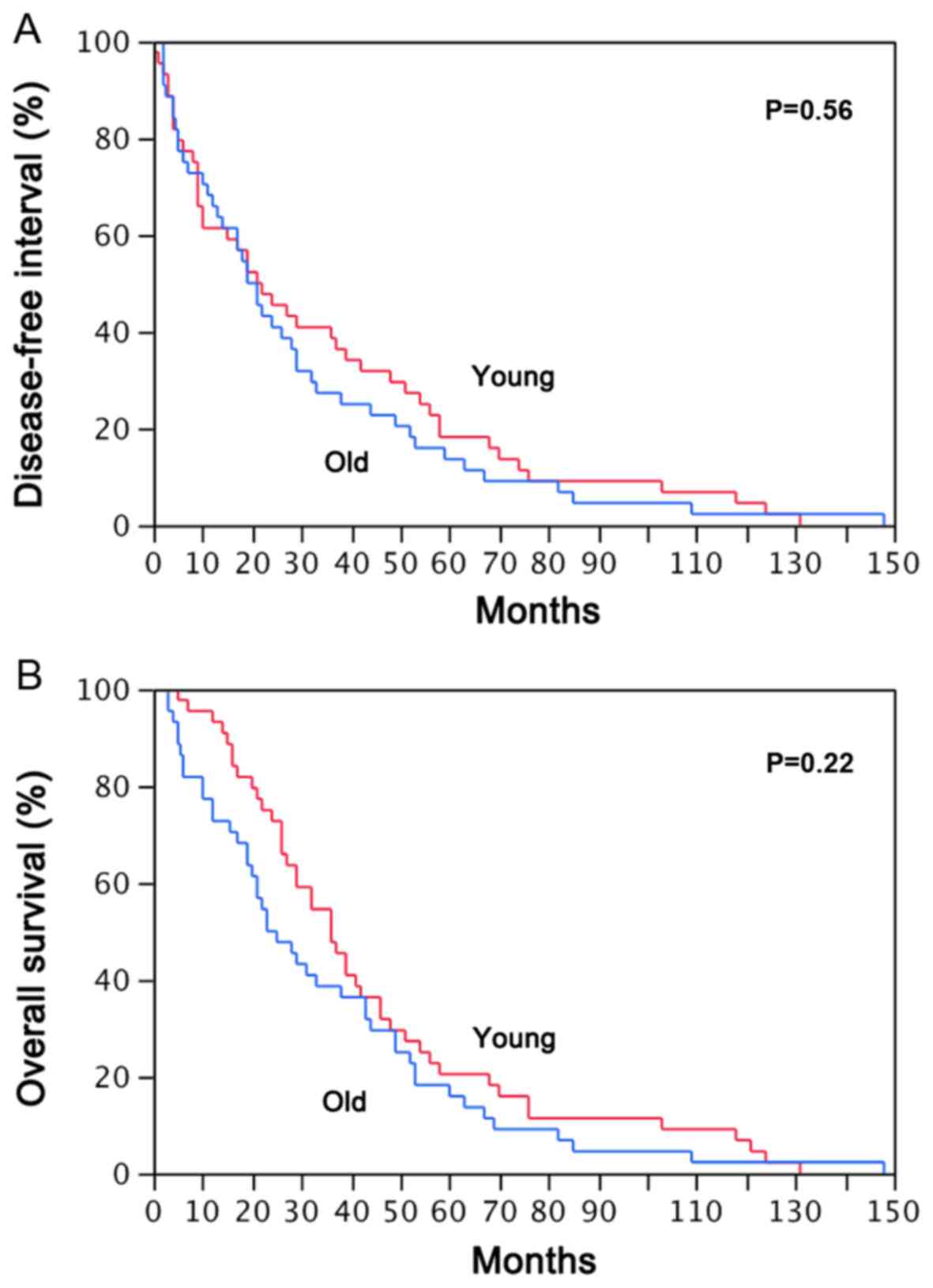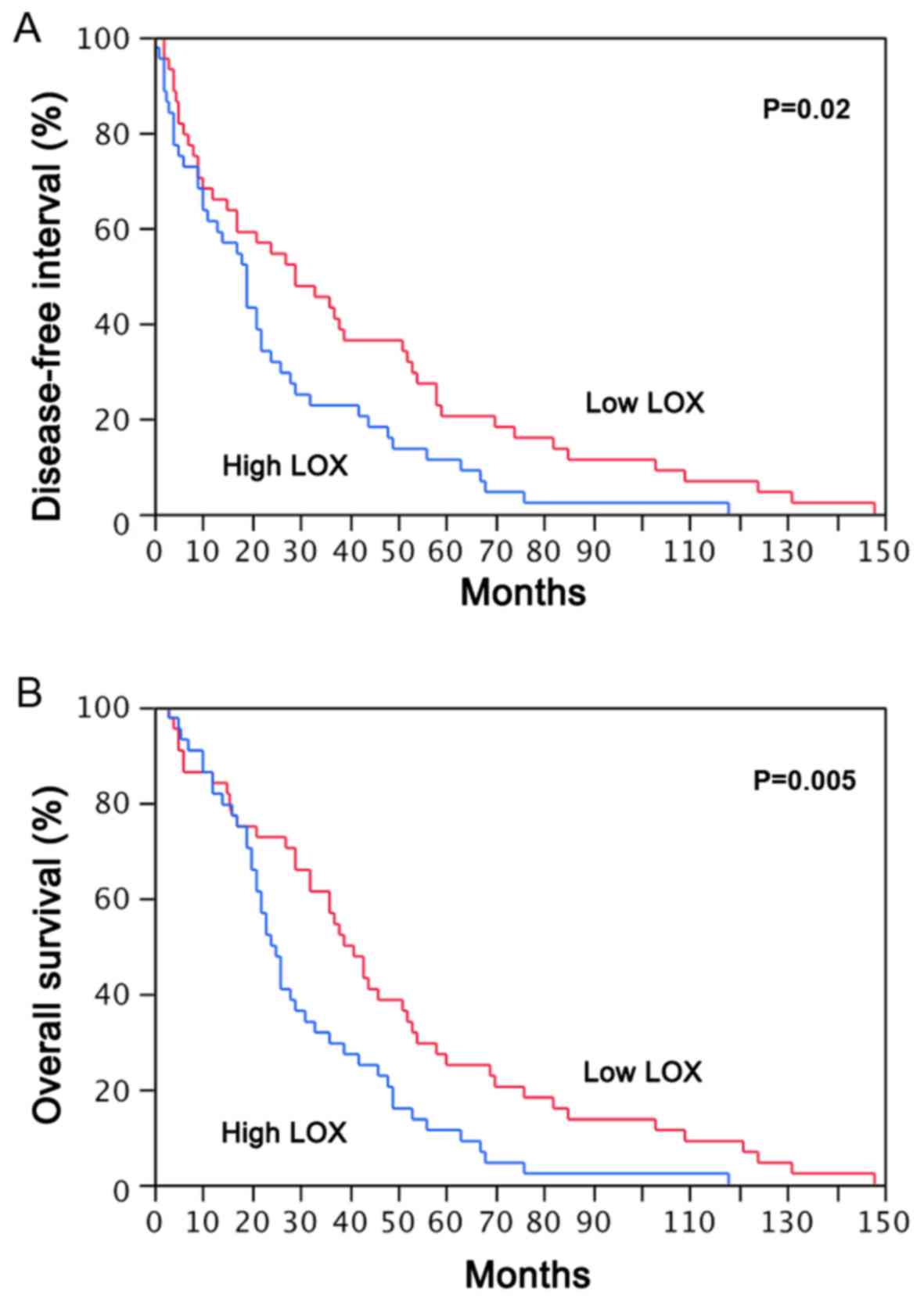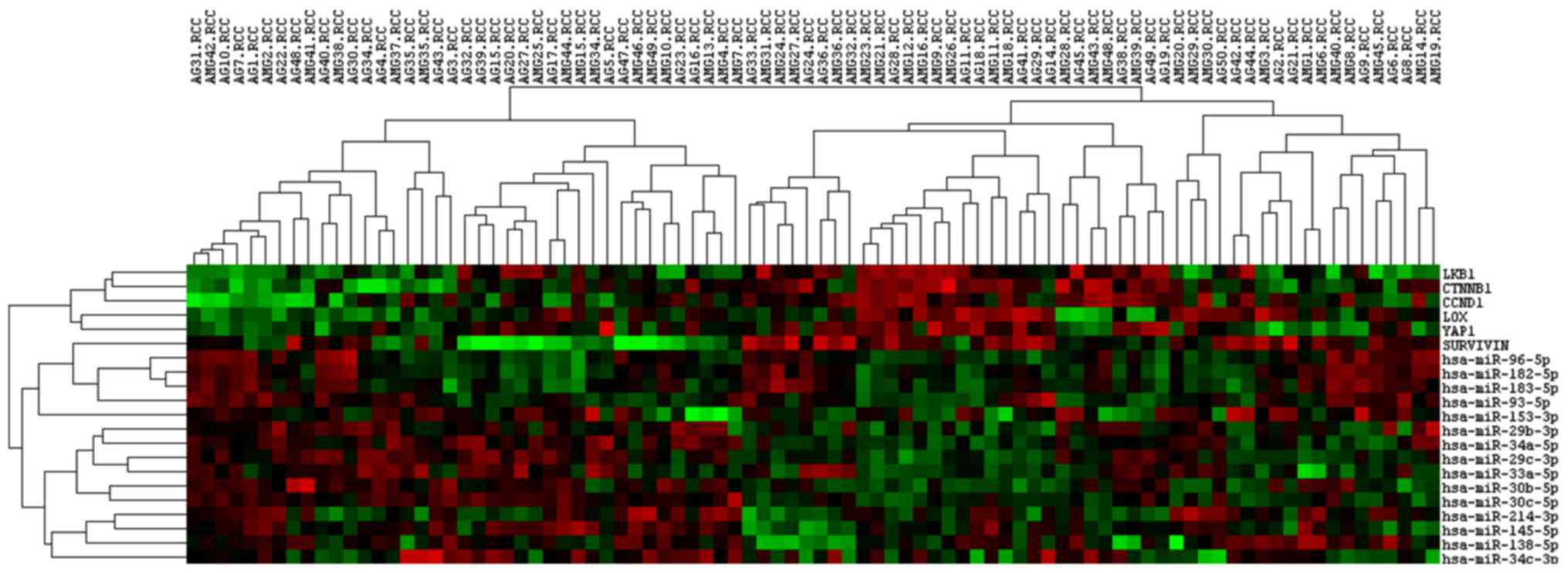|
1
|
Torre LA, Bray F, Siegel RL, Ferlay J,
Lortet-Tieulent J and Jemal A: Global cancer statistics, 2012. CA
Cancer J Clin. 65:87–108. 2015. View Article : Google Scholar : PubMed/NCBI
|
|
2
|
Ramalingam S, Pawlish K, Gadgeel S, Demers
R and Kalemkerian GP: Lung cancer in young patients: Analysis of a
Surveillance, Epidemiology, and End Results database. J Clin Oncol.
16:651–657. 1998. View Article : Google Scholar : PubMed/NCBI
|
|
3
|
Mauri D, Pentheroudakis G, Bafaloukos D,
Pectasides D, Samantas E, Efstathiou E, Kalofonos HP, Syrigos K,
Klouvas G, Papakostas P, et al: Hellenic Coopeprative Oncologic
Group (HeCOG): Non-small cell lung cancer in the young: A
retrospective analysis of diagnosis, management and outcome data.
Anticancer Res. 26(4B): 3175–3181. 2006.PubMed/NCBI
|
|
4
|
Subramanian J, Morgensztern D, Goodgame B,
Baggstrom MQ, Gao F, Piccirillo J and Govindan R: Distinctive
characteristics of non-small cell lung cancer (NSCLC) in the young:
A surveillance, epidemiology, and end results (SEER) analysis. J
Thorac Oncol. 5:23–28. 2010. View Article : Google Scholar : PubMed/NCBI
|
|
5
|
Zhang J, Chen SF, Zhen Y, Xiang J, Wu C,
Bao P, Luketich J, Hu H, Zhou X, Zhang J, et al: Multicenter
analysis of lung cancer patients younger than 45 years in Shanghai.
Cancer. 116:3656–3662. 2010. View Article : Google Scholar : PubMed/NCBI
|
|
6
|
Inoue M, Okumura M, Sawabata N, Miyaoka E,
Asamura H, Yoshino I, Tada H, Fujii Y, Nakanishi Y, Eguchi K, et
al: Clinicopathological characteristics and surgical results of
lung cancer patients aged up to 50 years: The Japanese Lung Cancer
Registry Study 2004. Lung Cancer. 83:246–251. 2014. View Article : Google Scholar : PubMed/NCBI
|
|
7
|
Lara MS, Brunson A, Wun T, Tomlinson B, Qi
L, Cress R, Gandara DR and Kelly K: Predictors of survival for
younger patients less than 50 years of age with non-small cell lung
cancer (NSCLC): A California Cancer Registry analysis. Lung Cancer.
85:264–269. 2014. View Article : Google Scholar : PubMed/NCBI
|
|
8
|
Rich AL, Khakwani A, Free CM, Tata LJ,
Stanley RA, Peake MD, Hubbard RB and Baldwin DR: Non-small cell
lung cancer in young adults: Presentation and survival in the
English National Lung Cancer Audit. QJM. 108:891–897. 2015.
View Article : Google Scholar : PubMed/NCBI
|
|
9
|
Travis WD, Brambilla E, Muller-Hemerlink
HK and Harris CC: World Health Organization Classification of
TumoursPathology and Genetics of Tumours of the Lung, Pleura,
Thymus and Heart. IARC press; Lyon: 2004
|
|
10
|
Korsse SE, Peppelenbosch MP and van Veelen
W: Targeting LKB1 signaling in cancer. Biochim Biophys Acta.
1835:194–210. 2013.PubMed/NCBI
|
|
11
|
Beroukhim R, Mermel CH, Porter D, Wei G,
Raychaudhuri S, Donovan J, Barretina J, Boehm JS, Dobson J,
Urashima M, et al: The landscape of somatic copy-number alteration
across human cancers. Nature. 463:899–905. 2010. View Article : Google Scholar : PubMed/NCBI
|
|
12
|
Hemminki A, Markie D, Tomlinson I,
Avizienyte E, Roth S, Loukola A, Bignell G, Warren W, Aminoff M,
Höglund P, et al: A serine/threonine kinase gene defective in
Peutz-Jeghers syndrome. Nature. 391:184–187. 1998. View Article : Google Scholar : PubMed/NCBI
|
|
13
|
Berasain C and Ávila MA: LKB1: Controlling
Quiescence and Genomic Integrity at Home. Trends Endocrinol Metab.
April 5–2018.(Epub ahead of print). View Article : Google Scholar : PubMed/NCBI
|
|
14
|
Fabian MR, Sonenberg N and Filipowicz W:
Regulation of mRNA translation and stability by microRNAs. Annu Rev
Biochem. 79:351–379. 2010. View Article : Google Scholar : PubMed/NCBI
|
|
15
|
Carretero J, Shimamura T, Rikova K,
Jackson AL, Wilkerson MD, Borgman CL, Buttarazzi MS, Sanofsky BA,
McNamara KL, Brandstetter KA, et al: Integrative genomic and
proteomic analyses identify targets for Lkb1-deficient metastatic
lung tumors. Cancer Cell. 17:547–559. 2010. View Article : Google Scholar : PubMed/NCBI
|
|
16
|
Zhang W, Gao Y, Li F, Tong X, Ren Y, Han
X, Yao S, Long F, Yang Z, Fan H, et al: YAP promotes malignant
progression of Lkb1-deficient lung adenocarcinoma through
downstream regulation of survivin. Cancer Res. 75:4450–4457. 2015.
View Article : Google Scholar : PubMed/NCBI
|
|
17
|
Calles A, Sholl LM, Rodig SJ, Pelton AK,
Hornick JL, Butaney M, Lydon C, Dahlberg SE, Oxnard GR, Jackman DM,
et al: Immunohistochemical loss of LKB1 is a biomarker for more
aggressive biology in KRAS-mutant lung adenocarcinoma. Clin Cancer
Res. 21:2851–2860. 2015. View Article : Google Scholar : PubMed/NCBI
|
|
18
|
Travis WD, Brambilla E, Noguchi M,
Nicholson AG, Geisinger KR, Yatabe Y, Beer DG, Powell CA, Riely GJ,
Van Schil PE, et al: International association for the study of
lung cancer/american thoracic society/european respiratory society
international multidisciplinary classification of lung
adenocarcinoma. J Thorac Oncol. 6:244–285. 2011. View Article : Google Scholar : PubMed/NCBI
|
|
19
|
Travis WD, Brambilla E, Noguchi M,
Nicholson AG, Geisinger K, Yatabe Y, Ishikawa Y, Wistuba I, Flieder
DB, Franklin W, et al: Diagnosis of lung cancer in small biopsies
and cytology: Implications of the 2011 International Association
for the Study of Lung Cancer/American Thoracic Society/European
Respiratory Society classification. Arch Pathol Lab Med.
137:668–684. 2013. View Article : Google Scholar : PubMed/NCBI
|
|
20
|
Zhang J, Qin L, Han L, Zhao Y, Jing H,
Song W and Shi H: Role of MicroRNA-93 in pathogenesis of left
ventricular remodelling via targeting cyclin-D1. Med Sci Monit.
23:3981–3988. 2017. View Article : Google Scholar : PubMed/NCBI
|
|
21
|
Tang Q, Zou Z, Zou C, Zhang Q, Huang R,
Guan X, Li Q, Han Z, Wang D, Wei H, et al: MicroRNA-93 suppress
colorectal cancer development via Wnt/β-catenin pathway
downregulating. Tumour Biol. 36:1701–1710. 2015. View Article : Google Scholar : PubMed/NCBI
|
|
22
|
Avtanski DB, Nagalingam A, Bonner MY,
Arbiser JL, Saxena NK and Sharma D: Honokiol activates LKB1-miR-34a
axis and antagonizes the oncogenic actions of leptin in breast
cancer. Oncotarget. 6:29947–29962. 2015. View Article : Google Scholar : PubMed/NCBI
|
|
23
|
Zhu XB, Zhang ZC, Han GS, Han JZ and Qiu
DP: Overexpression of miR 214 promotes the progression of human
osteosarcoma by regulating the Wnt/β catenin signaling pathway. Mol
Med Rep. 15:1884–1892. 2017. View Article : Google Scholar : PubMed/NCBI
|
|
24
|
Kang J, Kim W, Lee S, Kwon D, Chun J, Son
B, Kim E, Lee JM, Youn H and Youn B: TFAP2C promotes lung
tumorigenesis and aggressiveness through miR-183- and
miR-33a-mediated cell cycle regulation. Oncogene. 36:1585–1596.
2017. View Article : Google Scholar : PubMed/NCBI
|
|
25
|
Yabushita S, Fukamachi K, Tanaka H, Sumida
K, Deguchi Y, Sukata T, Kawamura S, Uwagawa S, Suzui M and Tsuda H:
Circulating microRNAs in serum of human K-ras oncogene transgenic
rats with pancreatic ductal adenocarcinomas. Pancreas.
41:1013–1018. 2012. View Article : Google Scholar : PubMed/NCBI
|
|
26
|
Wang D, Lu G, Shao Y and Xu D: miR-182
promotes prostate cancer progression through activating
Wnt/β-catenin signal pathway. Biomed Pharmacother. 99:334–339.
2018. View Article : Google Scholar : PubMed/NCBI
|
|
27
|
Beezhold K, Klei LR and Barchowsky A:
Regulation of cyclin D1 by arsenic and microRNA inhibits
adipogenesis. Toxicol Lett. 265:147–155. 2017. View Article : Google Scholar : PubMed/NCBI
|
|
28
|
Wu Z, He B, He J and Mao X: Upregulation
of miR-153 promotes cell proliferation via downregulation of the
PTEN tumor suppressor gene in human prostate cancer. Prostate.
73:596–604. 2013. View Article : Google Scholar : PubMed/NCBI
|
|
29
|
Liu X, Lv XB, Wang XP, Sang Y, Xu S, Hu K,
Wu M, Liang Y, Liu P, Tang J, et al: MiR-138 suppressed
nasopharyngeal carcinoma growth and tumorigenesis by targeting the
CCND1 oncogene. Cell Cycle. 11:2495–2506. 2012. View Article : Google Scholar : PubMed/NCBI
|
|
30
|
Waggott D, Chu K, Yin S, Wouters BG, Liu
FF and Boutros PC: NanoStringNorm: An extensible R package for the
pre-processing of NanoString mRNA and miRNA data. Bioinformatics.
28:1546–1548. 2012. View Article : Google Scholar : PubMed/NCBI
|
|
31
|
Tian DL, Liu HX, Zhang L, Yin HN, Hu YX,
Zhao HR, Chen DY, Han LB, Li Y and Li HW: Surgery for young
patients with lung cancer. Lung Cancer. 42:215–220. 2003.
View Article : Google Scholar : PubMed/NCBI
|
|
32
|
Liu NS, Spitz MR, Kemp BL, Cooksley C,
Fossella FV, Lee JS, Hong WK and Khuri FR: Adenocarcinoma of the
lung in young patients: The M. D. Anderson experience. Cancer.
88:1837–1841. 2000. View Article : Google Scholar : PubMed/NCBI
|
|
33
|
Kuo CW, Chen YM, Chao JY, Tsai CM and
Perng RP: Non-small cell lung cancer in very young and very old
patients. Chest. 117:354–357. 2000. View Article : Google Scholar : PubMed/NCBI
|
|
34
|
Skarin AT, Herbst RS, Leong TL, Bailey A
and Sugarbaker D: Lung cancer in patients under age 40. Lung
Cancer. 32:255–264. 2001. View Article : Google Scholar : PubMed/NCBI
|
|
35
|
Blanco M, García-Fontán E, Rivo JE, Repáaz
JR, Obeso GA and Cañizares MA: Bronchogenic carcinoma in patients
under 50 years old. Clin Transl Oncol. 11:322–325. 2009. View Article : Google Scholar : PubMed/NCBI
|
|
36
|
Weiss J and Langer C: Treatment of lung
cancer in the elderly patient. Semin Respir Crit Care Med.
34:802–809. 2013. View Article : Google Scholar : PubMed/NCBI
|
|
37
|
Davidoff AJ, Tang M, Seal B and Edelman
MJ: Chemotherapy and survival benefit in elderly patients with
advanced non-small-cell lung cancer. J Clin Oncol. 28:2191–2197.
2010. View Article : Google Scholar : PubMed/NCBI
|
|
38
|
Beckett P, Callister M, Tata LJ, Harrison
R, Peake MD, Stanley R, Woolhouse I, Slade M and Hubbard RB:
Clinical management of older people with non-small cell lung cancer
in England. Thorax. 67:836–839. 2012. View Article : Google Scholar : PubMed/NCBI
|
|
39
|
Meoni G, Cecere FL, Lucherini E and Di
Costanzo F: Medical treatment of advanced non-small cell lung
cancer in elderly patients: A review of the role of chemotherapy
and targeted agents. J Geriatr Oncol. 4:282–290. 2013. View Article : Google Scholar : PubMed/NCBI
|
|
40
|
Ye T, Pan Y, Wang R, Hu H, Zhang Y, Li H,
Wang L, Sun Y and Chen H: Analysis of the molecular and
clinicopathologic features of surgically resected lung
adenocarcinoma in patients under 40 years old. J Thorac Dis.
6:1396–1402. 2014.PubMed/NCBI
|
|
41
|
Kim L, Kim KH, Yoon YH, Ryu JS, Choi SJ,
Park IS, Han JY, Kim JM and Chu YC: Clinicopathologic and molecular
characteristics of lung adenocarcinoma arising in young patients. J
Korean Med Sci. 27:1027–1036. 2012. View Article : Google Scholar : PubMed/NCBI
|
|
42
|
Pan Y, Zhang Y, Li Y, Hu H, Wang L, Li H,
Wang R, Ye T, Luo X, Zhang Y, et al: ALK, ROS1 and RET fusions in
1139 lung adenocarcinomas: A comprehensive study of common and
fusion pattern-specific clinicopathologic, histologic and cytologic
features. Lung Cancer. 84:121–126. 2014. View Article : Google Scholar : PubMed/NCBI
|
|
43
|
Radzikowska E, Roszkowski K and Głaz P:
Lung cancer in patients under 50 years old. Lung Cancer.
33:203–211. 2001. View Article : Google Scholar : PubMed/NCBI
|
|
44
|
Sekine I, Nishiwaki Y, Yokose T, Nagai K,
Suzuki K and Kodama T: Young lung cancer patients in Japan:
Different characteristics between the sexes. Ann Thorac Surg.
67:1451–1455. 1999. View Article : Google Scholar : PubMed/NCBI
|
|
45
|
Shackelford DB, Abt E, Gerken L, Vasquez
DS, Seki A, Leblanc M, Wei L, Fishbein MC, Czernin J, Mischel PS,
et al: LKB1 inactivation dictates therapeutic response of non-small
cell lung cancer to the metabolism drug phenformin. Cancer Cell.
23:143–158. 2013. View Article : Google Scholar : PubMed/NCBI
|
|
46
|
Inge LJ, Coon KD, Smith MA and Bremner RM:
Expression of LKB1 tumor suppressor in non-small cell lung cancer
determines sensitivity to 2-deoxyglucose. J Thorac Cardiovasc Surg.
137:580–586. 2009. View Article : Google Scholar : PubMed/NCBI
|
|
47
|
Carretero J, Medina PP, Blanco R, Smit L,
Tang M, Roncador G, Maestre L, Conde E, Lopez-Rios F, Clevers HC,
et al: Dysfunctional AMPK activity, signalling through mTOR and
survival in response to energetic stress in LKB1-deficient lung
cancer. Oncogene. 26:1616–1625. 2007. View Article : Google Scholar : PubMed/NCBI
|
|
48
|
Mahoney CL, Choudhury B, Davies H, Edkins
S, Greenman C, Haaften G, Mironenko T, Santarius T, Stevens C,
Stratton MR, et al: LKB1/KRAS mutant lung cancers constitute a
genetic subset of NSCLC with increased sensitivity to MAPK and mTOR
signalling inhibition. Br J Cancer. 100:370–375. 2009. View Article : Google Scholar : PubMed/NCBI
|
|
49
|
Whang YM, Park SI, Trenary IA, Egnatchik
RA, Fessel JP, Kaufman JM, Carbone DP and Young JD: LKB1 deficiency
enhances sensitivity to energetic stress induced by erlotinib
treatment in non-small-cell lung cancer (NSCLC) cells. Oncogene.
35:856–866. 2016. View Article : Google Scholar : PubMed/NCBI
|
|
50
|
Jian SF, Hsiao CC, Chen SY, Weng CC, Kuo
TL, Wu DC, Hung WC and Cheng KH: Utilization of liquid
chromatography mass spectrometry analyses to identify LKB1-APC
interaction in modulating Wnt/β-catenin pathway of lung cancer
cells. Mol Cancer Res. 12:622–635. 2014. View Article : Google Scholar : PubMed/NCBI
|
|
51
|
Geiss GK, Bumgarner RE, Birditt B, Dahl T,
Dowidar N, Dunaway DL, Fell HP, Ferree S, George RD, Grogan T, et
al: Direct multiplexed measurement of gene expression with
color-coded probe pairs. Nat Biotechnol. 26:317–325. 2008.
View Article : Google Scholar : PubMed/NCBI
|
|
52
|
Reis PP, Waldron L, Goswami RS, Xu W, Xuan
Y, Perez-Ordonez B, Gullane P, Irish J, Jurisica I and Kamel-Reid
S: mRNA transcript quantification in archival samples using
multiplexed, color-coded probes. BMC Biotechnol. 11:462011.
View Article : Google Scholar : PubMed/NCBI
|
|
53
|
Mairinger FD, Walter RF, Werner R,
Christoph DC, Ting S, Vollbrecht C, Zarogoulidis K, Huang H, Li Q,
Schmid KW, et al: Activation of angiogenesis differs strongly
between pulmonary carcinoids and neuroendocrine carinomas and is
crucial for carcinoid tumourgenesis. J Cancer. 5:465–471. 2014.
View Article : Google Scholar : PubMed/NCBI
|
|
54
|
Veldman-Jones MH, Brant R, Rooney C, Geh
C, Emery H, Harbron CG, Wappett M, Sharpe A, Dymond M, Barrett JC,
et al: Evaluating robustness and sensitivity of the NanoString
Technologies nCounter platform to enable multiplexed gene
expression analysis of clinical samples. Cancer Res. 75:2587–2593.
2015. View Article : Google Scholar : PubMed/NCBI
|
|
55
|
Walter RF, Mairinger FD, Wohlschlaeger J,
Worm K, Ting S, Vollbrecht C, Schmid KW and Hager T: FFPE tissue as
a feasible source for gene expression analysis - a comparison of
three reference genes and one tumor marker. Pathol Res Pract.
209:784–789. 2013. View Article : Google Scholar : PubMed/NCBI
|
|
56
|
Chen L, Engel BE, Welsh EA, Yoder SJ,
Brantley SG, Chen DT, Beg AA, Cao C, Kaye FJ, Haura EB, et al: A
Sensitive NanoString-Based Assay to Score STK11 (LKB1) Pathway
Disruption in Lung Adenocarcinoma. J Thorac Oncol. 11:838–849.
2016. View Article : Google Scholar : PubMed/NCBI
|
|
57
|
Ujiie H, Kadota K, Chaft JE, Buitrago D,
Sima CS, Lee MC, Huang J, Travis WD, Rizk NP, Rudin CM, et al:
Solid Predominant Histologic Subtype in Resected Stage I Lung
Adenocarcinoma Is an Independent Predictor of Early, Extrathoracic,
Multisite Recurrence and of Poor Postrecurrence Survival. J Clin
Oncol. 33:2877–2884. 2015. View Article : Google Scholar : PubMed/NCBI
|
|
58
|
Du L, Zhao Z, Ma X, Hsiao TH, Chen Y,
Young E, Suraokar M, Wistuba I, Minna JD and Pertsemlidis A:
miR-93-directed downregulation of DAB2 defines a novel oncogenic
pathway in lung cancer. Oncogene. 33:4307–4315. 2014. View Article : Google Scholar : PubMed/NCBI
|
|
59
|
Xiao J, Zou Y, Chen X, Gao Y, Xie M, Lu X,
Li W, He B, He S, You S, et al: The Prognostic Value of Decreased
LKB1 in Solid Tumors: A Meta-Analysis. PLoS One. 11:e01526742016.
View Article : Google Scholar : PubMed/NCBI
|
|
60
|
Xu P, Zhao M, Liu Z, Liu Y, Chen Y, Luo R
and Fang W: Elevated nuclear CCND1 expression confers an
unfavorable prognosis for early stage lung adenocarcinoma patients.
Int J Clin Exp Pathol. 8:15887–15894. 2015.PubMed/NCBI
|
|
61
|
Deep G and Agarwal R: Targeting tumor
microenvironment with silibinin: Promise and potential for a
translational cancer chemopreventive strategy. Curr Cancer Drug
Targets. 13:486–499. 2013. View Article : Google Scholar : PubMed/NCBI
|
|
62
|
Gao Y, Xiao Q, Ma H, Li L, Liu J, Feng Y,
Fang Z, Wu J, Han X, Zhang J, et al: LKB1 inhibits lung cancer
progression through lysyl oxidase and extracellular matrix
remodeling. Proc Natl Acad Sci USA. 107:18892–18897. 2010.
View Article : Google Scholar : PubMed/NCBI
|
|
63
|
Hou X, Du H, Quan X, Shi L, Zhang Q, Wu Y,
Liu Y, Xiao J, Li Y, Lu L, et al: Silibinin Inhibits NSCLC
Metastasis by targeting the EGFR/LOX pathway. Front Pharmacol.
9:212018. View Article : Google Scholar : PubMed/NCBI
|
|
64
|
Zhong K, Chen K, Han L and Li B:
MicroRNA-30b/c inhibits non-small cell lung cancer cell
proliferation by targeting Rab18. BMC Cancer. 14:7032014.
View Article : Google Scholar : PubMed/NCBI
|
|
65
|
de la Cueva A, Emmerling M, Lim SL, Yang
S, Trackman PC, Sonenshein GE and Kirsch KH: A polymorphism in the
lysyl oxidase propeptide domain accelerates carcinogen-induced
cancer. Carcinogenesis. March 22–2018.(Epub ahead of print).
View Article : Google Scholar : PubMed/NCBI
|













